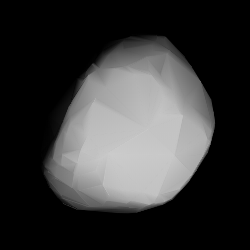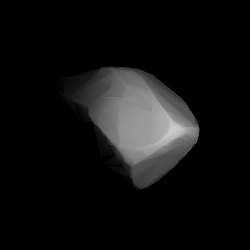1575 Winifred, provisional designation 1950 HH, is a stony Phocaea asteroid and slow rotator from the inner regions of the asteroid belt, approximately 9.5 kilometers in diameter.
2542 Calpurnia, provisionally designated 1980 CF, is a carbonaceous high-albedo asteroid from the outer regions of the asteroid belt, approximately 20 kilometers in diameter. It was discovered on 11 February 1980, by American astronomer Edward Bowell at Anderson Mesa Station, Flagstaff, United States. The asteroid was named after Julius Caesar's wife, Calpurnia.

1390 Abastumani is a very large and dark background asteroid from the outer region of the asteroid belt. It was discovered on 3 October 1935, by Russian astronomer Pelageya Shajn at the Simeiz Observatory on the Crimean peninsula. The primitive P-type asteroid has a rotation period of 17.1 hours and measures approximately 101 kilometers in diameter. It was named for the Georgian town of Abastumani.
3037 Alku, provisional designation 1944 BA, is a carbonaceous asteroid from the central region of the asteroid belt, approximately 20 kilometers in diameter. It was discovered on 17 January 1944, by Finnish astronomer Yrjö Väisälä at Turku Observatory in Southwest Finland.
2034 Bernoulli, provisional designation 1973 EE, is a stony asteroid from the inner regions of the asteroid belt, approximately 9 kilometers in diameter.
2038 Bistro, provisional designation 1973 WF, is a stony asteroid from the inner regions of the asteroid belt, approximately 12 kilometers in diameter. The asteroid was discovered on 24 November 1973, by Swiss astronomer Paul Wild at the Zimmerwald Observatory near Bern, Switzerland. It was named for the Bistro restaurant.

1805 Dirikis, provisional designation 1970 GD, is a stony Themistian asteroid from the outer region of the asteroid belt, approximately 26 kilometers in diameter.
3687 Dzus, provisional designation A908 TC, is a carbonaceous asteroid from the central region of the asteroid belt, approximately 31 kilometers in diameter. It was discovered by German astronomer August Kopff at Heidelberg-Königstuhl State Observatory on 7 October 1908.
1936 Lugano, provisional designation 1973 WD, is a carbonaceous Adeonian asteroid from the middle region of the asteroid belt, approximately 26 kilometers in diameter.

1841 Masaryk (prov. designation: 1971 UO1) is a carbonaceous background asteroid from the outer region of the asteroid belt, approximately 46 kilometers in diameter. It was discovered on 26 October 1971, by Czech astronomer Luboš Kohoutek at Bergedorf Observatory in Hamburg, Germany. The asteroid was named after the first President of Czechoslovakia, Tomáš Garrigue Masaryk.

4222 Nancita (prov. designation: 1988 EK1) is a bright background asteroid and upcoming Mars-crosser on an eccentric orbit from the inner regions of the asteroid belt. It was discovered on 13 March 1988, by American astronomer Eleanor Helin at Palomar Observatory in California, United States. The S-type asteroid has a rotation period of 3.9 hours and measures approximately 9 kilometers (5.6 miles) in diameter. It was named after the discoverer's daughter-in-law, Nancy Coker Helin.
1405 Sibelius, provisional designation 1936 RE, is a stony Florian asteroid from the inner regions of the asteroid belt, approximately 8 kilometers in diameter. It was discovered on 12 September 1936, by Finnish astronomer Yrjö Väisälä at Turku Observatory in Southwest Finland. The asteroid was named after composer Jean Sibelius.
3345 Tarkovskij, provisional designation 1982 YC1, is a carbonaceous background asteroid from the inner regions of the asteroid belt, approximately 22 kilometers (14 miles) in diameter. It was discovered on 23 December 1982, by Russian astronomer Lyudmila Karachkina at the Crimean Astrophysical Observatory in Nauchnyj, on the Crimean peninsula, and named after filmmaker Andrei Tarkovsky. The C-type asteroid is a slow rotator with a rotation period of 187 hours.
1585 Union, provisional designation 1947 RG, is a dark background asteroid from the outer regions of the asteroid belt, approximately 52 kilometers in diameter. It was discovered on 7 September 1947, by South African astronomer Ernest Johnson at the Union Observatory in Johannesburg, South Africa. The asteroid was named after the discovering observatory.
1734 Zhongolovich, provisional designation 1928 TJ, is a carbonaceous Dorian asteroid from the central region of the asteroid belt, approximately 28 kilometers in diameter.
1461 Jean-Jacques, provisional designation 1937 YL, is a metallic asteroid from the outer region of the asteroid belt, approximately 34 kilometers in diameter. It was discovered on 30 December 1937, by French astronomer Marguerite Laugier at Nice Observatory in southern France, who named it after her son Jean-Jacques Laugier.
1535 Päijänne, provisional designation 1939 RC, is an asteroid from the outer region of the asteroid belt, approximately 25 kilometers in diameter. It was discovered on 9 September 1939, by Finnish astronomer Yrjö Väisälä at the Turku Observatory in Southwest Finland. It was later named for Lake Päijänne.
2058 Róka, provisional designation 1938 BH, is a Themistian asteroid from the outer regions of the asteroid belt, approximately 22 kilometers in diameter.
1481 Tübingia, provisional designation 1938 DR, is a dark asteroid from the outer region of the asteroid belt, approximately 34 kilometers in diameter. It was discovered on 7 February 1938, by German astronomer Karl Reinmuth at Heidelberg Observatory in southern Germany, and named for the German city of Tübingen.
1544 Vinterhansenia, provisional designation 1941 UK, is a dark asteroid from the inner regions of the asteroid belt, approximately 22 kilometers in diameter. It was discovered on 15 October 1941, by Finnish astronomer Liisi Oterma at Turku Observatory in Southwest Finland, and named for Danish astronomer Julie Vinter Hansen.




